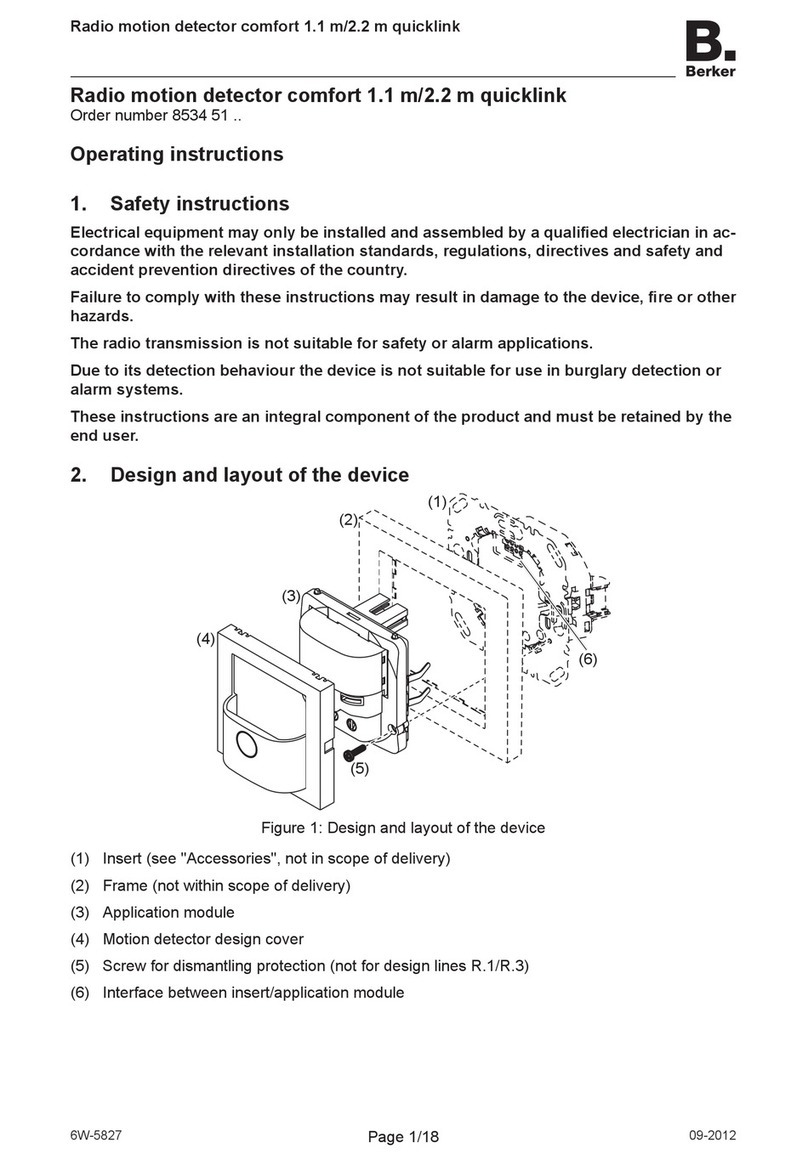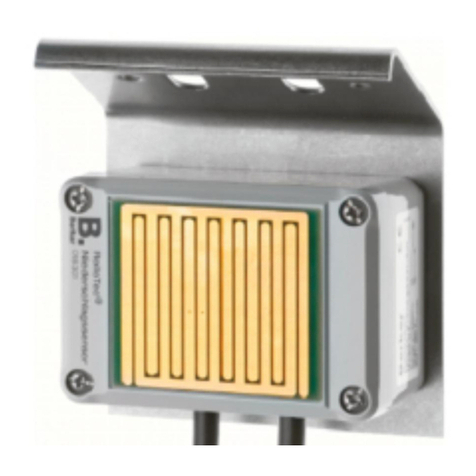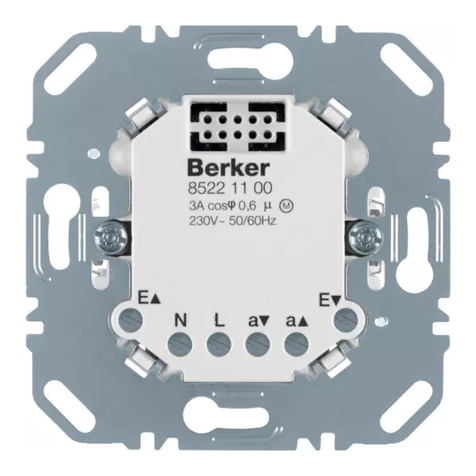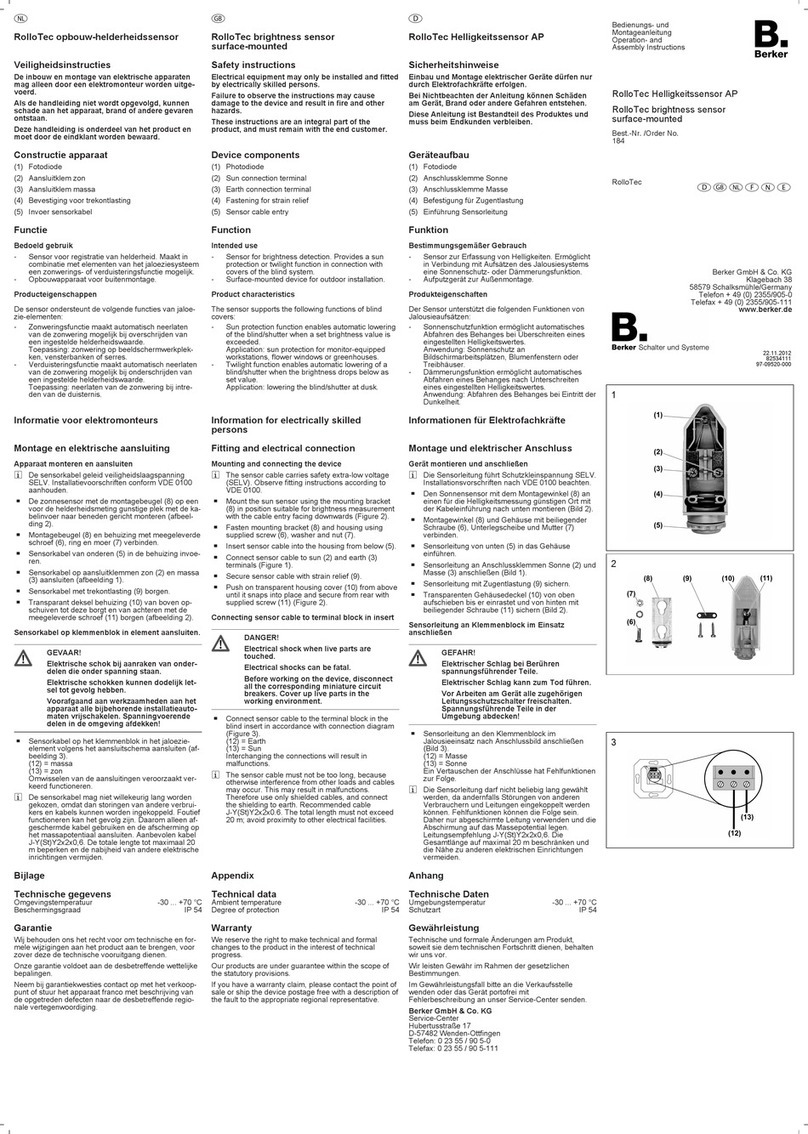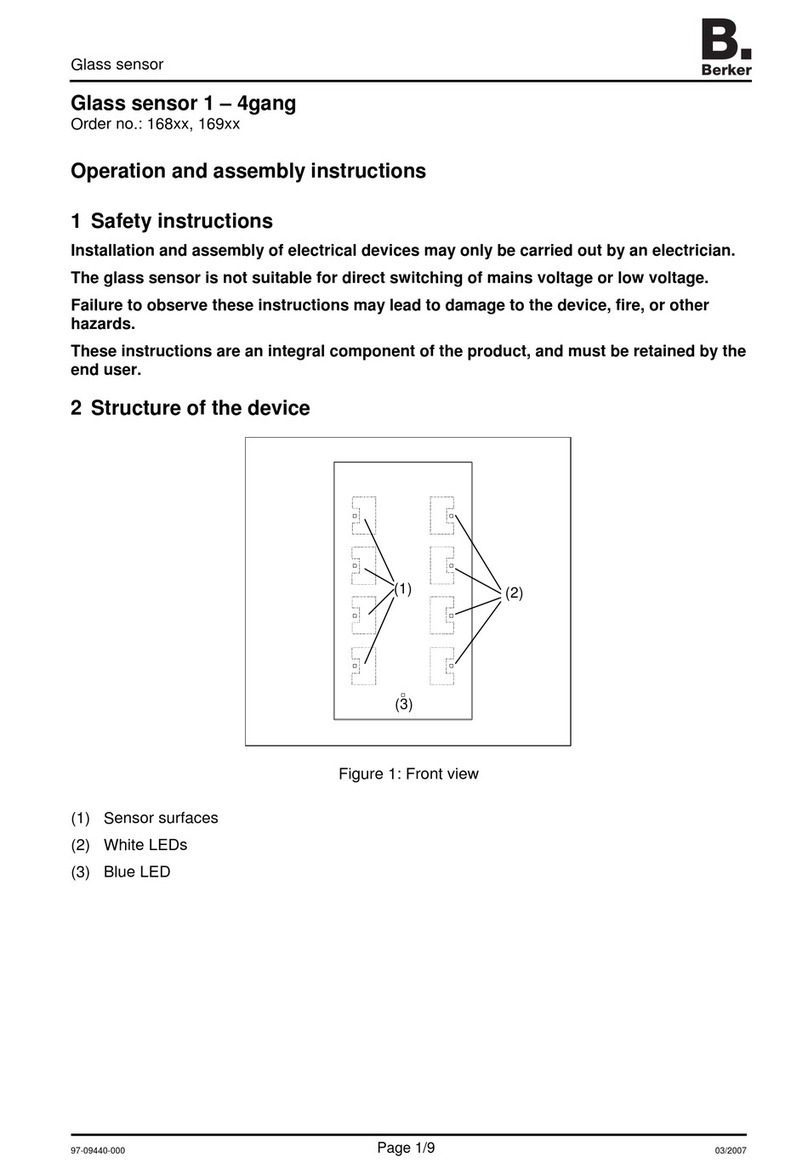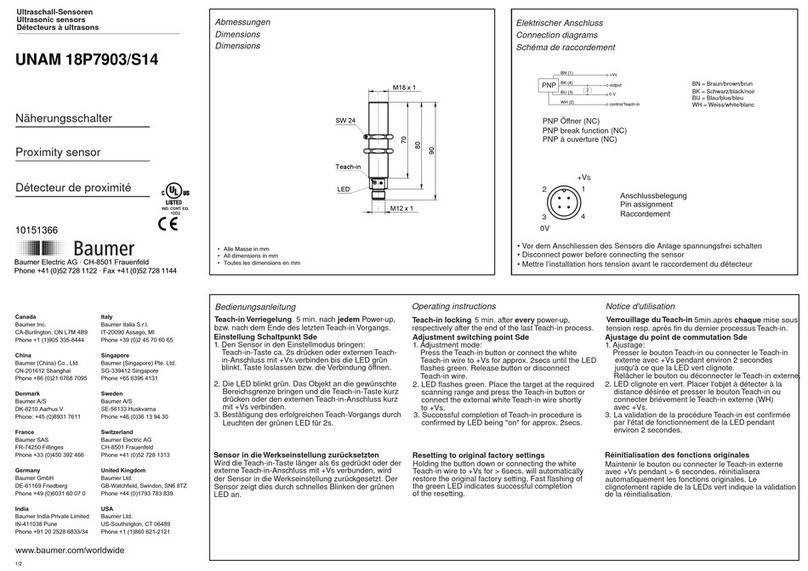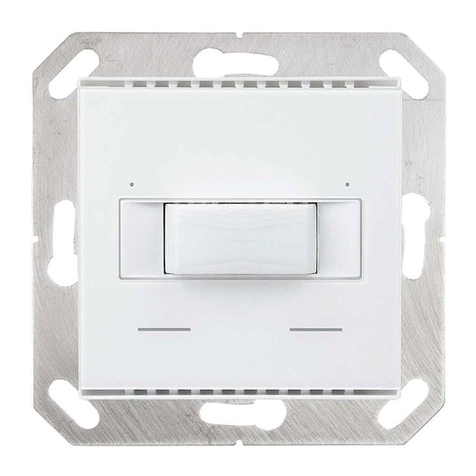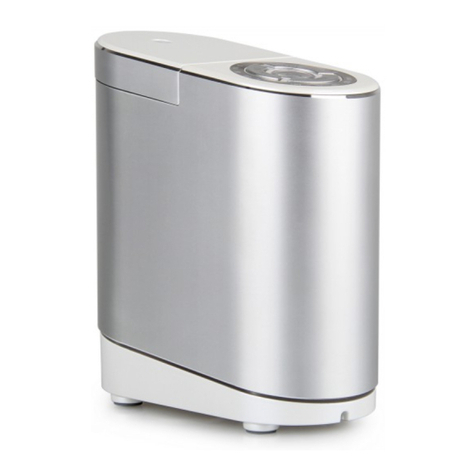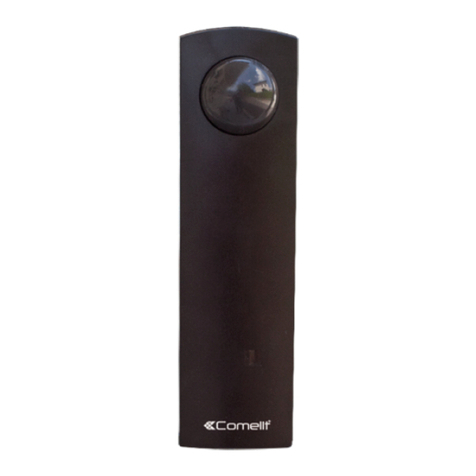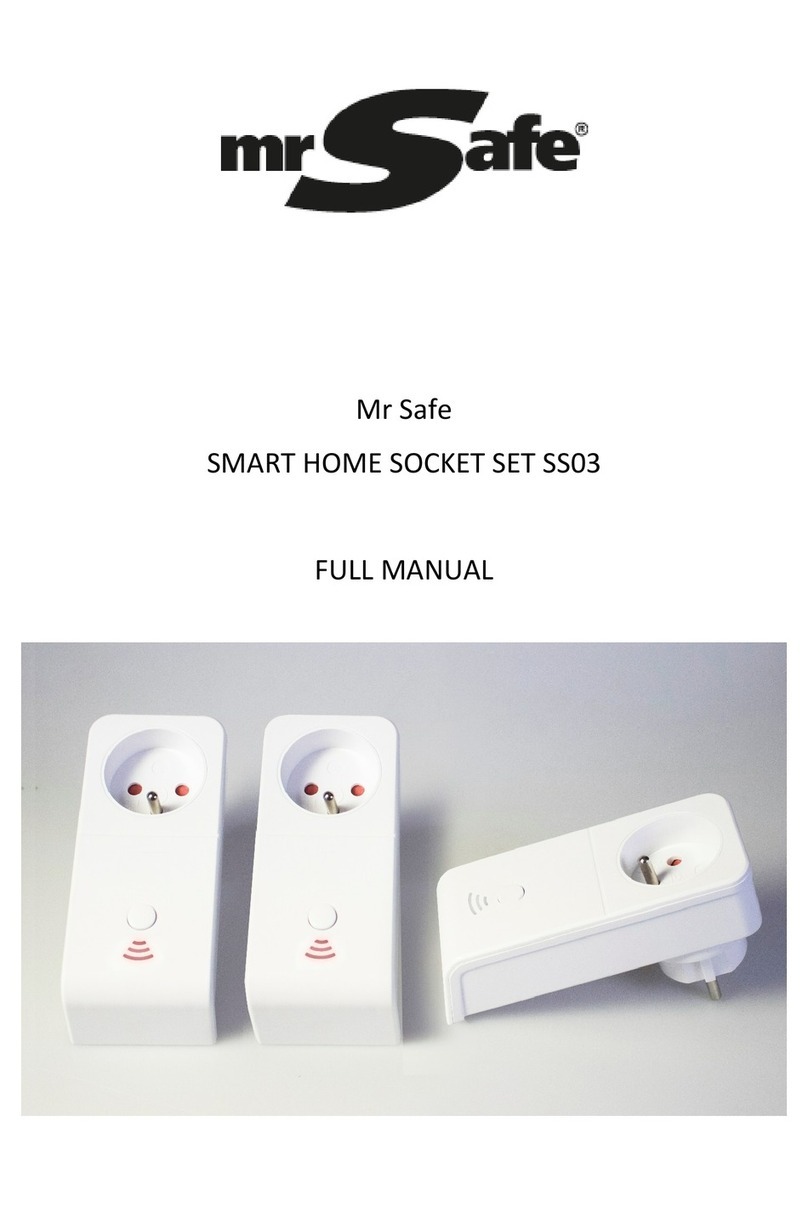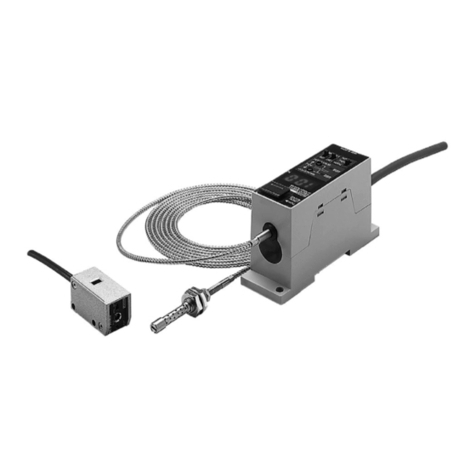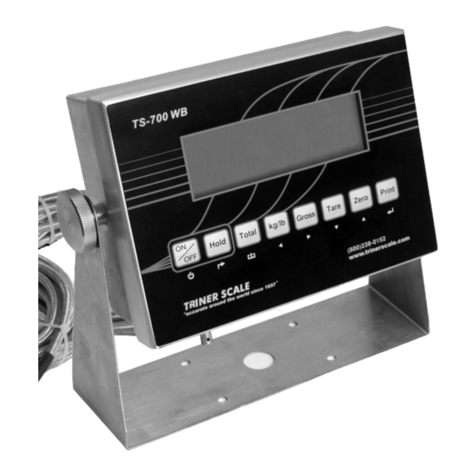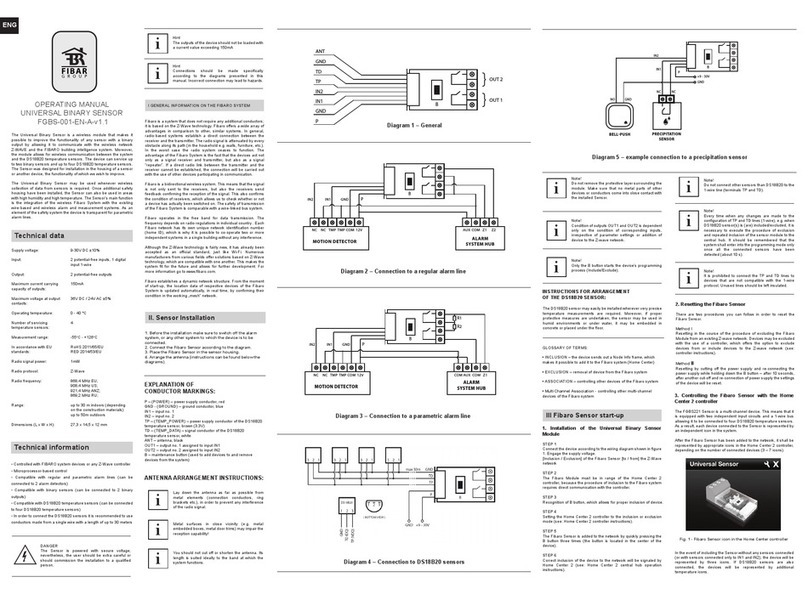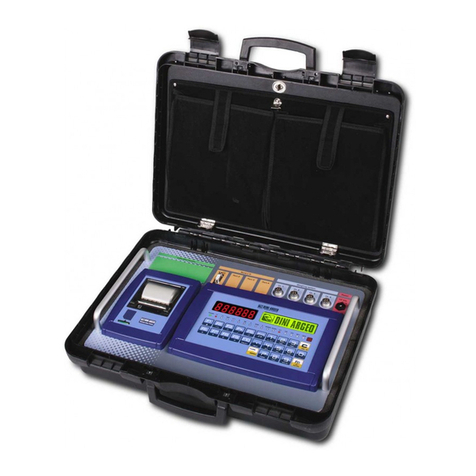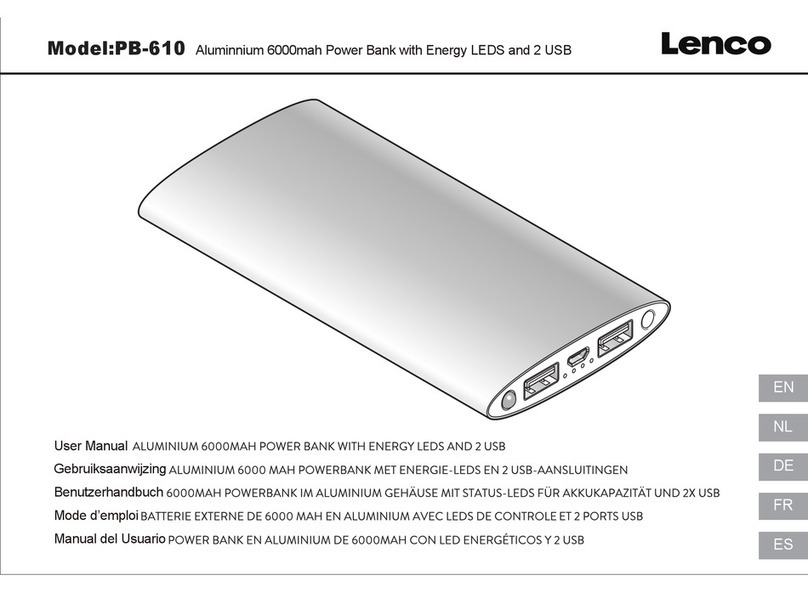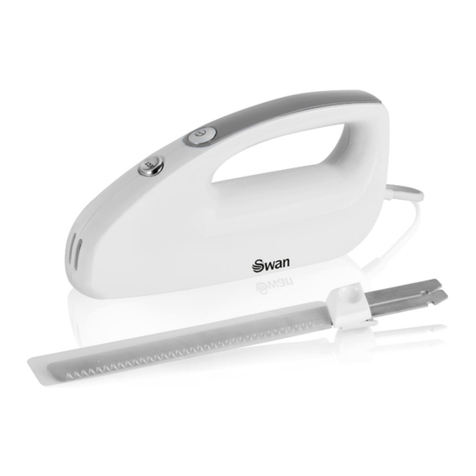Berker 8534 12 series User manual

Page 1/13
6W-5826 09-2012
IR motion detector comfort
IR motion detector comfort 1.1 m
Order no. 8534 12 xx
IR motion detector comfort 2.2 m
Order no. 8534 22 xx
Operating instructions
1. Safety instructions
Electrical equipment may only be installed and assembled by a qualied electrician in ac-
cordance with the relevant installation standards, regulations, directives and safety and
accident prevention directives of the country.
Failure to comply with these installation instructions may result in damage to the device,
re or other hazards.
Due to its detection behaviour the device is not suitable for use in burglary detection or
alarm systems.
These instructions are an integral component of the product and must be retained by the
end user.
2. Design and layout of the device
(3)
(4)
(5)
(2)
(1)
(6)
Figure 1: Design and layout of the device
(1) Insert (see "Accessories", not in scope of delivery)
(2) Frame (not within scope of delivery)
(3) Application module
(4) Motion detector design cover
(5) Screw for dismantling protection (not for design lines R.1/R.3)
(6) Interface between insert/application module

Page 2/13
6W-5826 09-2012
IR motion detector comfort
3. Function
Correct use
–Automatic switching of lighting depending on heat motion and ambient brightness
–Application module for switch insert, ush-mounted dimmer or motion detector extension
unit
–Only suitable for use in indoor areas with no drip and no spray water.
Product characteristics
–Integrated button for selecting operating modes and special functions
–Lockable integrated button
–Operating mode - automatic mode, permanent ON, permanent OFF can be selected
–Display operating mode via LED
–Potentiometer for adjusting the response brightness, delay time and detection sensitivity
–Delay time adjustable
–Pulse encoder mode for current pulse/stairwell circuits
–Adjustable detection angle for adaptation of the detection area
–Additional adjustment of the response brightness via Teach-In function
–Party function
–Presence simulation
–Operation on motion detector extension units
–Optional extension unit operation via installation button
–Start-up via IR hand-held transmitter
Automatic mode
The motion detector detects heat motion caused by people, animals, or objects.
Applied on switch insert:
–The light will be switched on for the delay time, if movements are detected in the detection
area and the set brightness threshold is undershot. Each detected movement restarts the
delay time.
–The light will be switched off if no additional movements are detected in the detection area
and the set delay time has elapsed.
On ush-mounted dimmer:
–The light will be switched on to the switch-on brightness level for the delay time if
movements are detected in the detection area and the set brightness threshold is
undershot. Each detected movement restarts the delay time.
–After the delay time elapses the lighting will be dimmed to 50% of the switch-on brightness-
level and will remain at this brightness level for 30 s (switch-off pre-warning). Each
movement detected during the switch-off pre-warning restarts the delay time and restores
the switch-on brightness level.
–The light will be switched off if no motion is detected any longer in the detection area and
the set delay time and the switch-off time have elapsed.
On extension unit
–If motion is detected in the detection area of the extension unit, the extension unit insert
sends a pulse to the main unit and then locks for 10 seconds. Recording takes place in-
dependently of the brightness on the extension unit. If motion is still detected after 10 se-
conds, a pulse is sent again.
–Upon receiving an extension unit pulse, the main unit switches the light on for the delay
time, if the set brightness threshold is undershot. Every further extension unit pulse restarts
the delay time of the main unit.
Performance after mains breakdown/return of mains supply
–Mains breakdown shorter than 0.2 s:

Page 3/13
6W-5826 09-2012
IR motion detector comfort
The function is not impaired.
–Mains breakdown longer than 0.2 s:
There is no function during the mains breakdown. The current conguration is saved in
non-volatile memory.
–Return of mains supply:
The application module executes an initialisation for approx. 15 s, during which the lighting
will be switched on. Motion detection starts thereafter. If no motion is detected during the
rst 5 s, the lighting is switched off. The saved conguration is loaded from memory. During
this period local operation via the button or extension unit can be used.
4. Operation
Operating concept
(8)
(7)
Fig. 2: Operating and display elements
(7) Button
(8) Status LED
Operation is executed by pushing the button (7) on the motion detector:
–A short press of the button switches the operating modes. The operating mode is displayed
via the status LED behind the optics cover of the motion detector.
–Keeping the button pressed activates special functions. Selection of the special functions is
supported by the LED display (Fig. 3).
Function Party function Teach-In Keylock Presence
simulation
Load setting
mode
LED display
Hold time
operation
button
> 5 s > 10 s > 15 s > 20 s > 25 s
1) Only on universal switch insert and universal ush-mounted dimmer
Fig. 3: Selection of the special functions and LED display
Selecting the operating mode
Briey press the button repeatedly until the desired operating mode is selected.
The status LED indicates the selected operating mode (see Table 1).
Switching the operating mode nishes the party function or presence simulation, if these
functions were previously active.

Page 4/13
6W-5826 09-2012
IR motion detector comfort
LED display Operating
mode
On switch insert or
ush-mounted dimmer
On extension unit insert
-- Auto Motion-dependent and
brightness-dependent switch
on/switch off of the load
Motion-independent switching
pulse for the main unit
green Permanent
ON
Load is permanently switched-
on/switched-off.
Extension unit signals will not
be evaluated
Cyclical transmission of the
switch-on pulse every 10 s
red Permanent
OFF
--
Table 1: Display of operating modes
Disabling/enabling operating mode selection via button
Keep the button pressed for more than 15 seconds, until the status LED is ashing green
(Fig. 3).
Selection of the operating mode via the button is disabled.
or if the button is locked:
Keep the button pressed for more than 15 seconds, until the status LED is ashing green
(Fig. 3).
Selection of the operating mode via the button is possible again.
Switch on the lighting via push-button extension unit or change the switch-on bright-
ness-level
The lighting can be switched on via a mechanical push-button extension unit.
For extension unit operation, the lighting is switched on independently of the set brightness
threshold.
When using the ush-mounted dimmers, the last set brightness level will be saved as the
switch-on brightness-level.
Dimming status Operation button Performance of the insert
Motion detector applied on switch insert
OFF Short press Load is switched on for the set delay time
ON Short press Extension of switch-on time by the set delay time
Motion detector applied on ush-mounted dimmer
OFF Short press Load is switched on to the switch-on brightness-
level for the set delay time
ON Short press Extension of switch-on time by the set delay time
at the same brightness
OFF Long press Load is switched on to switch-on brightness-
level, subsequent dimming in the opposite
direction of the last dimming process. Thereafter
the load remains switched on for the delay time
ON Long press Changes the current brightness. Dimming
takes place in the opposite direction of the last
dimming operation until maximum or minimum
brightness. Subsequently the load remains
switched on at the set brightness for the set
delay time.
Table 2: Operation via push-button extension unit

Page 5/13
6W-5826 09-2012
IR motion detector comfort
Activating/interrupting party function
The party function switches the lighting on for 2 hours. During this time no extension unit com-
mands are executed.
In the case of motion detectors on extension units, activating the party function causes cy-
clical transmission of the switch-on pulse every 10 s. However, the light is only switched on
if the brightness threshold is undershot at the main unit.
Keep the button pressed for more than 5 seconds, until the status LED is ashing red (Fig.
3).
The lighting is switched on for 2 hours. During this time the status LED is ashing red.
Upon elapse of 2 hours, the motion detector switches to Auto operation mode.
Briey press the button.
The party function will be cancelled, the motion detector returns to Auto operation mode.
Setting response brightness via Teach-In function
The response brightness is the brightness value saved in the motion detector; when this value
is undershot the motion detector switches the connected load if movements are detected. Via
Teach-In function the current ambient brightness is saved as the response brightness.
Teach-In cannot be carried out on the extension unit.
The load is switched off.
Keep the button pressed for more than 10 seconds, until the status LED is ashing orange
(Fig. 3).
The motion detector detects the current ambient brightness and saves it as response
brightness.
Setting of the response brightness via Teach-In function and via the brightness potentiome-
ter has the same priority. Teach-In overwrites the response brightness set on the brightness
potentiometer. If the setting is made again via the potentiometer , the Teach-In gure will be
overwritten.
Activating/deactivating presence simulation
During operation, the motion detector counts the motion detections in one full hour and saves
the result. With active presence simulation at the beginning of the hour with the most detections
saved, the light will be switched on for the duration of the delay time, even no motion is detec-
ted.
During the presence simulation, presence detection and extension unit commands will continue
to be executed normally.
The presence simulation cannot be activated via the extension unit.
Keep the button pressed for more than 20 seconds, until the status LED is slowly ashing
red (Fig. 3).
The presence simulation is active. During this time the status LED lights orange. The moti-
on detector switches the lighting on at the saved time.
Briey press the button.
The presence simulation will be disabled, the motion detector returns to Auto mode.
Setting the load
If the dimming and switching performance of loads is unsatisfactory after start-up, especially
when circuited to energy-saving lamps and 230 V LED lamps, a load setting must be carried out
for universal switch inserts or universal touch dimmers when using the motion detector.
Switch off load.

Page 6/13
6W-5826 09-2012
IR motion detector comfort
Keep the button pressed for more than 25 seconds, until the status LED is slowly ashing
orange.
The connected load blinks once. The device is in selection mode.
If there is no further operation within the next 10 seconds, the insert swiches to switching/
dimming operation.
Briey press the button repeatedly to activate the desired setting mode (Table 3).
The load setting is executed.
Briey
press the
button
Setting mode Conrmation of the
load setting Notes
1 x Load ne-setting Load blinks 1 x after
approx. 30 s and changes
to switching/dimming ope-
ration
Not suitable for ohmic loads (e.g. incandescent,
HV halogen lamps); use factory load setting.
If the load ne-setting does not bring any impro-
vement for energy-saving lamps or 230 V LED
lamps, select the energy-saving lamp ne-setting
or 230 V LED lamp universal setting.
2 x Factory load setting Load blinks 2 x after
approx. 6 s and changes
to switching/dimming ope-
ration
3 x Energy-saving lamp
ne-setting in phase
cut-on
Load blinks 3 x after
approx. 30 s and changes
to switching/dimming ope-
ration
Energy-saving lamps are switched ON at a
brightness level of at least 50% brightness in
order to ensure an ignition process.
4 x 230 V LED lamp
universal setting in
phase cut-off
Load blinks 4 x after
approx. 5 s and changes
to switching/dimming ope-
ration
The universal setting contains standard values
which enable the operation of typical dimmable
230 V LED lamps.
For all setting modes Load blinks 5 x The selected setting mode is not supported by
the insert.
Table 3: Load setting mode
5. Information for electricians
5.1 Installation and electrical connection
Selecting installation location
Observe the motion orientation: a distinction is made between "direct approach" and "trans-
verse motion". Motions transverse to the motion detector can be detected better than moti-
ons toward the motion detector (Fig. 4).
Select an installation location that is free of vibration. Vibrations can cause undesired
switching.
Avoid sources of interference in the detection area. Sources of interference, e.g. heating
elements, ventilation systems, air conditioners and lamps that are cooling down can cause
undesired switching (Fig. 4).
To avoid disturbing inuences, the detection angle can be restricted (see Restriction of the
detection area).

Page 7/13
6W-5826 09-2012
IR motion detector comfort
180°
çç
1,10 m
2,2 m
Fig 4: Installation location of the motion detectors
Assembly of the device (Figure 1)
Information on electrical connection are to be taken from the operating instruction of for the
insert.
Attach the bottom part of the application module (3) together with frame (2) to a suitable
insert (1) and establish a connection between insert and the application module via the in-
terface between application and power module (6).
As soon as voltage is supplied to the application module, the status LED indicates the com-
patibility to the insert used.
Status LED display Meaning
LED blinks green (approx.
5 s until motion detection is
active)
Compatible
LED blinks red for 5 s Not compatible
If available, x dismantling protection with screw (5).
After start-up, click the design cover (4) into place on the application module (3).
If start-up is to take place using a hand-held transmitter, set the response brightness poten-
tiometer (Figure 5, 13) to the T position and then snap on the design cover.

Page 8/13
6W-5826 09-2012
IR motion detector comfort
5.2 Start-up
Overview of operation and adjustment elements
(9)(14)(14) (9)
(11)
(10)
(10)
(12)
(13)
(13)
Fig. 5: Operating and adjustment elements of the bottom part of the application module
(9) Sensitivity potentiometer
(10) Button
(11) Detection angle adjuster
(12) Status LED
(13) Delay time potentiometer
(14) Response brightness potentiometer
Setting the detection area
1.75 m
1.1 m
8 m
8 m
180°
2 m 4 m 6 m 8 m 10 m
12 m
Figure 6: detection area of the motion detector for mounting height 1.1 m
2 m
6 m6 m 4 m 6 m 8 m 10 m
~ 3°
1.1 m
2.2 m
1.75 m
8 m
Figure 7: detection area of the motion detector for mounting height 2.2 m
The detection angle can be restricted for the right side and for the left side via each adjuster
(Fig. 5, 10) between 45° ... 90°. Thus, the detection angle can be between 90° and 180° (Fig.
8).
Use the adjusters to set the detection angle for each side.
~10°

Page 9/13
6W-5826 09-2012
IR motion detector comfort
T
150
90°
...
45° 45°
...
90°
fct
cfg
T
150
90°
...
45° 45°
...
90°
fct
cfg
T
150
90°
...
45° 45°
...
90°
fct
cfg
T
150
90°
...
45° 45°
...
90°
fct
cfg
T
150
90°
...
45° 45°
...
90°
fct
cfg
T
150
90°
...
45° 45°
...
90°
fct
cfg
~ 180° ~ 135° ~ 90°
Fig. 8: Setting the detection angle
Setting the detection performance
Test mode must be used to test the detection performance. In test mode, the motion detector
works independent of brightness. Each detection switches the lighting and the status LED on for
3 seconds. Thereafter motion detection will be deactivated for 2 seconds.
The motion detector is connected and ready for operation.
Setting the test mode. To do so, set the response brightness potentiometer (Fig. 5, 14) to
the T position.
Leave the detection area and observe the switching behaviour.
If the motion detector switches on without motion in the detection eld, then sources of in-
terference (see Installation location) are present or the sensitivity is set too high.
Reduce the sensitivity if necessary and blank out sources of interference by adjusting the
detection angle or removing them.
Check the detection area using a detection test and adjust if necessary.
If the detection area is too small, it can be extended via motion detector extension units.
Setting the response brightness
The response brightness is the brightness value saved in the motion detector; when this value
is undershot the motion detector switches the connected load if movements are detected. The
response brightness can be set between approx. 5 () over 150 Lux (factory setting) to daytime
operation (). The symbol stands for brightness-independent switching. The response bright-
ness can be variably adjusted in the intermediate areas.
In order to control the lighting in stairwells in accordance with DIN EN12464-1, 2003-3,
select the 150 Lux potentiometer setting.
Turn the response brightness potentiometer (Fig. 5, 14) to the desired position.
To save the current ambient brightness as response brightness, use the Teach-In function
(see Setting the response brightness via Teach-In function).
As the brightness evaluation only takes place via the main unit, there is no need to set the
response brightness on extension units.
Set delay time
The delay time is the period of time saved in the motion detector which is the shortest time that
the lighting is switched on for when the response brightness is undershot and motion is detec-
ted.

Page 10/13
6W-5826 09-2012
IR motion detector comfort
The delay time can be set to pulse encoder mode or to the dened values 10 s, 1 min., 3 min.
(factory setting), 10 min. and 30 min. The setting is setting is innitely variable between the in-
termediate areas. On delivery, the delay time comes to 3 minutes.
Note that lights can be worn down due to frequent switching with very short delay times..
Turn the delay time potentiometer (Figure 5, 13) to the desired position.
Setting the pulse encoder mode
Pulse encoder mode is suitable for controlling stair light/current pulse circuits. In pulse encoder
mode, the 200 ms switching output is switched on when the response brightness is undershot
and movement is detected. Motion detection is then locked for 10 s.
Turn the delay time potentiometer (Figure 5, 13) to the position .
Setting the sensitivity
Detection is factory-set to maximum sensitivity. If there are frequent incorrect detections, the
sensitivity can be reduced.
Turn the sensitivity potentiometer (Fig. 5, 9) to the desired position.
5.3 Start-up and operation with the hand-held setting transmitter
The motion detector can also be started up and congured using a hand-held conguration
transmitter (order no. 8560 91 00). For this, the device has an IR receiver diode.
During operation, point the front end of the of the hand-held transmitter towards the IR re-
ceiver diode.
2,2 m
Figure 9: Using the hand-held transmitter
Activating/deactivating the motion detector for activation via hand-held transmitter
Set the response brightness potentiometer (Figure 5, 13) to the Tposition.
From now on, operation and settings must be made using the hand-held transmitter.
Potentiometer settings made on the device will no longer be evaluated.
Set a response brightness which deviates from T on the potentiometer to deactivate control
via the hand-held transmitter.

Page 11/13
6W-5826 09-2012
IR motion detector comfort
Choosing settings
The response brightness potentiometer of the motion detector is in the T position.
(15)
(16)
(17)
(18)
(21)
(20)
(19)
Figure 10: Key assignment of the hand-held transmitter
Short press on button of the hand-held transmitter.
The selected action/setting is executed (see table)
Area
(Figure
10)
Function of the group Button Action/setting
(15) Operation of the controlled load via the
motion detector
Always running, even if the remote con-
trol and setting function for the motion
detector are locked via the .running,
even if the remote control and setting
function for the motion detector is locked
via the .
Motion- and brightness-dependent
switching on/switching off of the load
Activate the presence simulation
Activate permanent OFF
Activate permanent ON
(16) Setting of the response brightness approx. 5 Lux, night operation
approx. 150 Lux, stairwell operation
Independent of brightness, daytime operation
Save current brightness via Teach-In
(17) Setting of sensitivity Minimum sensitivity
Medium sensitivity
Maximum sensitivity
(21) Setting the delay time Pulse encoder mode
Delay time setting , e.g. 1 minute
(18) Lock/unlock (see Locking the hand-held
transmitter or Locking the setting function
for motion detectors).
Lock
Unlock
(19) Setting of special functions Press > 2 s: reset to factory setting
Briey press the button: activate Test mode
(20) Unsupported buttons, no function. --
--
--

Page 12/13
6W-5826 09-2012
IR motion detector comfort
Locking/unlocking the hand-held transmitter
If the hand-held transmitter is locked, no IR signals are transmitted when the buttons are
pressed. The exceptions to this are the operation buttons (Figure 10, 15) and the locking but-
tons (18). These are always active.
Press the and buttons simultaneously for 1 s.
The setting buttons of the hand-held transmitter are deactivated.
Press the and buttons simultaneously again for 1 s to unlock.
Locking/unlocking the setting function for motion detector
If the setting function is locked, then the lock relates to a motion detector. This does not ac-
cept any IR setting signals during the lock. When the buttons on the hand-held transmitter are
pressed, then infrared signals will continue to be sent, e.g. to control other motion detectors.
Briey press the button on the hand-held transmitter.
The controlled motion detector does not accept any further setting commands.
Briey press the button on the hand-held transmitter.
The setting function is unlocked. The motion detector accepts setting commands.
6. Appendix
6.1 Technical data
Connection Mounting on suitable inserts
Power supply via inserts
Response brightness approx. 5 ... 1000 lux (∞)
Delay time approx. 10 s ... 30 min
Sensitivity approx. 10 ... 100 %
Detection angle approx. 90 ... 180°
Detection area (1.1 m) approx. 12 x 16 m
Detection area (2.2 m) approx. 8 x 12 m
Degree of protection IP 20
Relative humidity 0 ... 65 % (no condensation)
Ambient temperature -5 … +45 °C
Storage/transport temperature -20 … +60 °C
Mounting orientation Interface between application and power module at top
6.2 Accessories
Relay insert 8512 12 0x
Universal switch insert 1-gang 8512 11 0x
Touch dimmer (R, L) 8542 11 0x
Universal touch dimmer 1gang 8542 12 0x
Motion detector extension unit 8532 01 0x

Page 13/13
6W-5826 09-2012
IR motion detector comfort
6.3 Warranty
We reserve the right to make technical and formal changes to the product in the interest of tech-
nical progress.
Our products are under guarantee within the scope of the statutory provisions.
If you have a warranty claim, please contact the point of sale or ship the device postage free
with a description of the fault to the appropriate regional representative.
This manual suits for next models
1
Table of contents
Other Berker Accessories manuals


